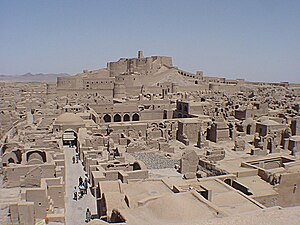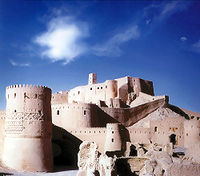Bam, Iran
| UNESCO World Heritage Site | |
|---|---|
 | |
| Criteria | Cultural: ii, iii, iv, v |
| Reference | 1208 |
| Inscription | 2004 (28th Session) |
| Endangered | 2004— |
Bam is a city in Kerman Province of Iran. The city is the center of Bam County. The modern Iranian city of Bam surrounds the Bam citadel. Before the 2003 earthquake the official population count of the city was of around 90,000.[1] There are various opinions about the date and reasons for the foundation of the citadel. Some people believe that Bam city was founded during the Parthian empire, a very powerful Persian empire, that ruled from 250 BCE to 226 CE. Economically and commercially, Bam occupied a very important place in the region and was famed for its textiles and clothes. Ibn Hawqal (943–977), the Arab traveller and geographer, wrote of Bam in his book Surat-ul-`ard (The Earth-figure):
- Over there they weave excellent, beautiful and long-lasting cotton cloths which are sent to distant countries and cities. There they also make excellent clothes, each of which costs around 30 dinars; these are sold in Khorasan, Iraq and Egypt.
The ancient citadel of Arg-é Bam probably has a history dating back around 2000 years ago, to the Parthian dynasty (248 BC–224 AD), but most buildings were built during the Safavid dynasty. The city was largely abandoned due to an Afghan invasion in 1722, which overcame a weak Iranian government and ended Safavid rule. Subsequently, after the city had gradually been re-settled, it was abandoned a second time due to an attack by invaders from Shiraz. It was also used for a time as an army barracks.
The modern city of Bam was established later than the old citadel. It has gradually developed as an agricultural and industrial centre, and until the 2003 earthquake was experiencing rapid growth. In particular, the city is known for its dates and citrus fruit. The city also benefited from tourism, with an increasing number of people visiting the ancient citadel in recent years.
Etymology of the word Bam

About the origin of the word Bam, there are some links even to the mythical history of Iran, namely according to some sources[who?] “Bam” is metamorphosis of the word “Bahman”, which is the name of a king, about whom Ferdowsi (940?–1020?), narrated in his most famous work Shahnameh (The Book of Kings). In the poem, Bahman was the son of Esfandiyar who had fought against Rostam, one of the chief heroes in the Shahnameh. As Ferdowsi epically narrates, Bahman fights against one of the sons of Rostam, who was called Faramarz. A sandstorm hindered Faramarz and Bahman defeated him; as a triumph he built a fortress on the rock hill there, where the Bam Citadel is now situated.
2003 earthquake

On December 26, 2003 at 5:26 AM local time(1:56 AM UTC) Bam Citadel — "the biggest adobe structure of the world" — and most of the city of Bam proper were devastated by an earthquake. The United States Geological Survey estimated its magnitude as 6.6 on the Richter scale.[2] The BBC reported that "70% of the modern city of Bam" was destroyed.[3] Death toll numbers as high as 80,000 were rumoured on the street and 70,000 reported in the media. However, the total death toll was given as 56,230 on January 17 and the latest estimate from Tehran has halved previous estimates to 26,271 deaths. An additional 10,000 – 50,000 were reported injured, however this number is very uncertain; the most reported number is 30,000, which may have originated from an early Reuters account. According to the Iranian news agency IRNA, the old Bam Citadel was "levelled to the ground".
An international relief effort to help the survivors got under way as soon as news of the scale of the disaster reached the outside world. Rescue efforts quickly became a body recovery exercise, with many of the dead being buried in mass graves with the mullahs sanctioning abbreviated Islamic burial rites due to the huge numbers and fear of disease. The high death toll occurred because very few people who were trapped when their mud-brick homes collapsed managed to survive. Rescue workers reported that the collapsing mud-brick structures had completely disintegrated and buried people in piles of earth, rather than trapping them in voids or air pockets between building slabs, as would happen in a concrete building collapse. Those few who did survive being trapped were generally rescued within the first few hours, after being dug out by local survivors, or were trapped in ventilated air pockets. Among the survivors of the earthquake was 97-year-old Sharbānou Māzandarānī (شهربانو مازندرانی in Persian), who was trapped in her home for eight days. Rescue workers took three hours to dig her out after sniffer dogs found her. She survived by being under a table near a ventilation pipe.[4]
The international relief effort staged in the earthquake's aftermath helped to thaw relations somewhat between Iran and western countries. Numerous countries (including the United States and UK) sent supplies and search-and-rescue teams including the International Rescue Corps. In February of 2004 Bam was visited by Charles, Prince of Wales, a further indication of the improvement of international relations following the disaster.[5]
A documentary about this earthquake has been produced titled Bam 6.6.
Post 2003 Development
Immediately following the 2003 earthquake the Iranian government began to plan a new city based on modern city planning theories in order to eliminate problems that existed with the old city. The development of the plan took at least six months and resulted in significant complaints against the central government and local government by the Bam earthquake survivors.[citation needed] Nevertheless, the government in Tehran continued its plans and currently the city is being rebuilt. The citadel is also being rebuilt with specialist care from the Ministry of Culture and from Japanese universities.
On 16 March 2007 a 130 km/h sandstorm hit the city of Bam without warning, suffocating 3 children, killing 2 in car accidents, and wounding 14 others.[6]
References
- ^ "Cold is the main health threat after the Bam earthquake". BMJ. Retrieved 2007-09-13.
- ^ "Magnitude 6.6 - Southeastern Iran". U.S. Geological Survey. Retrieved 2007-09-13.
- ^ "Iran earthquake kills thousands". BBC News. Retrieved 2007-09-13.
- ^ "97-year-old quake victim rescued in Iran". China Daily. Retrieved 2007-09-13.
- ^ "Prince Charles tours quake-hit Bam". Guardian Unlimited. Retrieved 2007-09-13.
- ^ "5 killed in Bam sand storm". IRIB News. Retrieved 2007-09-13.
External links
- Travel magazine story on Bam as a tourist destination
- Newspaper item: "The Lost Beauty that was Bam"
- BBC story: "Bam: Jewel of Iranian heritage"
- Population figures from World-Gazetteer.com
- Digital Silk Roads Project – Citadel of Bam. Photos and movies
- To Bam & back by Asghar Riahi
2003 earthquake
- BBC news report
- CNN news report
- CNN report on rescue efforts
- IRINNews.org "Special on Bam three months on"
- IRINNews.org "Tehran lowers Bam earthquake toll"
Earthquake Reconstruction
- Reconstruction efforts in quake-devastated Bam continue two years on
- Arg-e Bam – The BAM Citadel – Film Documentary:
- Arg e Bam Movie Documentary – The BAM Citadel


